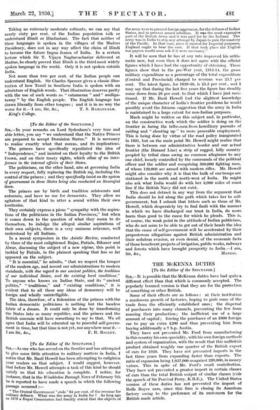[To the Editor of the SPECTATOR.]
SIR,-Sir Charles Spencer has repudiated, in a letter which appeared in the Spectator of March 15th, the claim of Hindi or Hindustani. to be the universal language of India. But the census of 1921 tells the contrary tale.
Hindi is the vernacular of over a hundred million ,people. About fifteen million speak Bihari and Rajasthan,_ which are closely akin to Hindi. Every one of the twenty million people, whose mother tongue is Panjabi, can talk and under- stand Hindi, as.. proficiently as Sir Charles Spencer can talk English. Besides, we have others who can understand Hindi or Hindustani with the greatest facility. One can safely say that these languages are widely prevalent throughout Northern India. Even in Bengal, where nearly fifty million people have a language of their own, the bivernment officials are asked to learn Hindi or Hindustani, so that they will find no difficulty in dealing with their subordinates.
tamil and Telugu are the principal languages of Southern India. But these are together spoken by about forty million people only. Hindustani is the spoken tongue of the Native. State of Hyderabad, which is in Southern India. It is also widely spoken in the districts which lie between the Madras Presidency and Hyderabad, in most of the districts of Mysore like Hassan, Shimoga, Kadur, &c., and in the ceded districts. The people of the Northern circars may be said to possess a fair knowledge of Hindustani. Mr. Mukerjk census super- intendent of Baroda, mentions the curious practice of some of the Deccan castes of speaking Hindustani between themselves.
It is definitely mentioned in the census Report of 1921 that the total speakers of Hindi far exceed in number the strength of any other individual language in India.. Things have greatly changed since the compilation of that Report. In the important cities of Southern India; " Hindi-Prachar Sabahs " have been established, and young students have flocked to these institutions, which hold annual exam- inations and award diplomas. The authorities of these schools have also published many bookS, which enable the people to learn Hindi by self-tuition. Thousands of people in Southern India have taken advantage of these publications which will give them a working proficiency of Hindi in the course of six months.
Taking an extremely moderate estimate, we can say that nearly sixty per cent. of the Indian population talk or understand Hindi or Hindustani. The fact that neither of these languages is spoken in the villages of the Madras Presidency, does not in any way affect the claim of Hindi to become the future lingua franca of India. In a certain lecture which Sir T. Vijaya Naghavachariar delivered at. Madras, he clearly proved that Hindi is the third most widely spoken language in the world. Only it is not spoken outside India.
Not more than two per cent. of the Indian people can understand English. Sir Charles Spencer gives a classic illus tration of how Tamil in Southern India is spoken with an admixture of English words. That illustration deserves parity with the use of such words as " catamaran " and " mulliga- tawny " by the English people. The English language has drawn liberally from other tongues ; and it is in no way the



















































 Previous page
Previous page